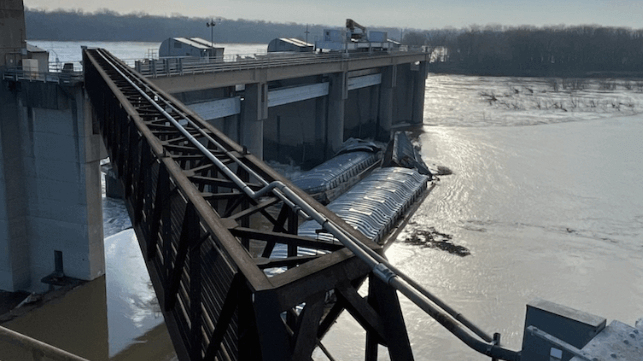NTSB: High Current Led to Allision at McAlpine Locks

The NTSB has released a report on the allision of a barge tow with a lock structure on the Ohio River in March 2023, concluding that the $2 million accident was due to high current and human error.
In late March, the Ohio River at the McAlpine Dam was approaching 15 feet and rising, triggering an "extreme high water / extreme high flow" warning. The Coast Guard broadcast a notice to mariners warning them to exercise caution in the area, given the high outdraft currents from the dam. Eight of the dam's nine gates were open to let the excess flow past.
On the morning of March 27, the towboat Queen City got under way on the Ohio near Hebron, Kentucky, downbound and headed for Paducah. She had 11 barges in tow as she neared the McAlpine Locks. At the time, the locks' upper gage measured 17.5 feet of water, well above the "extreme" level.
At about 0218 on March 28, the pilot was alone on watch in the wheelhouse and approaching the locks. As soon as he was clear of the Clark Memorial Highway Bridge, about 800 yards from the lock, the current began to set the tow to starboard at a rate of about one knot - towards the Vane Dike and the lower dam gates. It "started grabbing me, it wasn't looking good," he later told investigators. The pilot ordered a deckhand to call the captain, and the master got out of bed and was on his way to the wheelhouse when he felt Queen City's tow hit the tip of the Vane Dike mooring cell.
The tow broke apart on impact, and six barges went through the dam gates. The current pinned three more across the gates, including one barge filled with methanol, the only hazmat cargo in the tow. Because of the risks of a methanol release, the river was closed to navigation temporarily and a unified command organized a response. After planning, a commercial salvor lightered off the methanol cargo and recovered the damaged barges from the waterway. The cost of repairing the barges came to about $1.5 million, and the lost cargo (corn) was worth about $500,000.
The pilot had seven years of experience and had been working aboard Queen City for about 18 months. He had transited the same route more than a dozen times before, he said, but this was the highest water he had ever experienced.
The risk of an allision at the McAlpine Lock and Dam was well known, and the local pilotage advisory guide cautions mariners to "exercise extreme caution, enter chambers at slowest safe speed, and prepare for potential outdrafts." The dike was hit twice in a month in February 2022 alone, according to NTSB, and AIS data showed that other tows in 2023 had been set towards it by the current.
NTSB determined that the cause of the Queen City allision was the pilot's failure to compensate for the strong outdraft during high current conditions.
"Near dams, greater dam openings in high-water conditions lead to high flow rates, which can produce outdraft currents near the dam. Mariners should thoroughly assess the potential impact of outdraft currents when entering or exiting locking channels," NTSB cautioned.
